LinkLayerAI Litepaper#
Overview#
LinkLayerAI is a decentralized incentive protocol powered by various types of strategy trading Agents and Agent SaaS (AaaS). Strategy and trading Agents are primarily designed to serve Web3 users, while Agent SaaS delivers standardized services to meet the diverse strategy data needs of different traders. Together, these Agents and AaaS form the foundation of a decentralized incentive system that tokenizes access to AI services and promotes intelligent utilization and value interaction of strategy data across the ecosystem.
To enhance the usability of the LinkLayerAI protocol (LLA), the system integrates a multi-dimensional AI product ecosystem focused on trading strategy data scenarios. This includes Web3 Strategy Agents, the Agent SaaS (AaaS) platform, and a growth-oriented DApp. Based on the concept of “Agent-as-a-Service, Data-as-Rights,” these products enable multi-dimensional trading data aggregation and service delivery, forming a unified Agent-driven data infrastructure for users, traders, and trading communities. Under the incentive-driven mechanism of the protocol, different ecosystem participants can efficiently access Agent services while obtaining corresponding decentralized rights within LinkLayerAI.
LinkLayerAI introduces an innovative digital rights and governance token system to balance the interests of different ecosystem participants across various stages. This model maximizes ecosystem activation and ensures long-term sustainability. This litepaper will elaborate on key components including AaaS, Strategy Agent, and the AI+Web3 economy built around the incentive core of the LLA protocol.
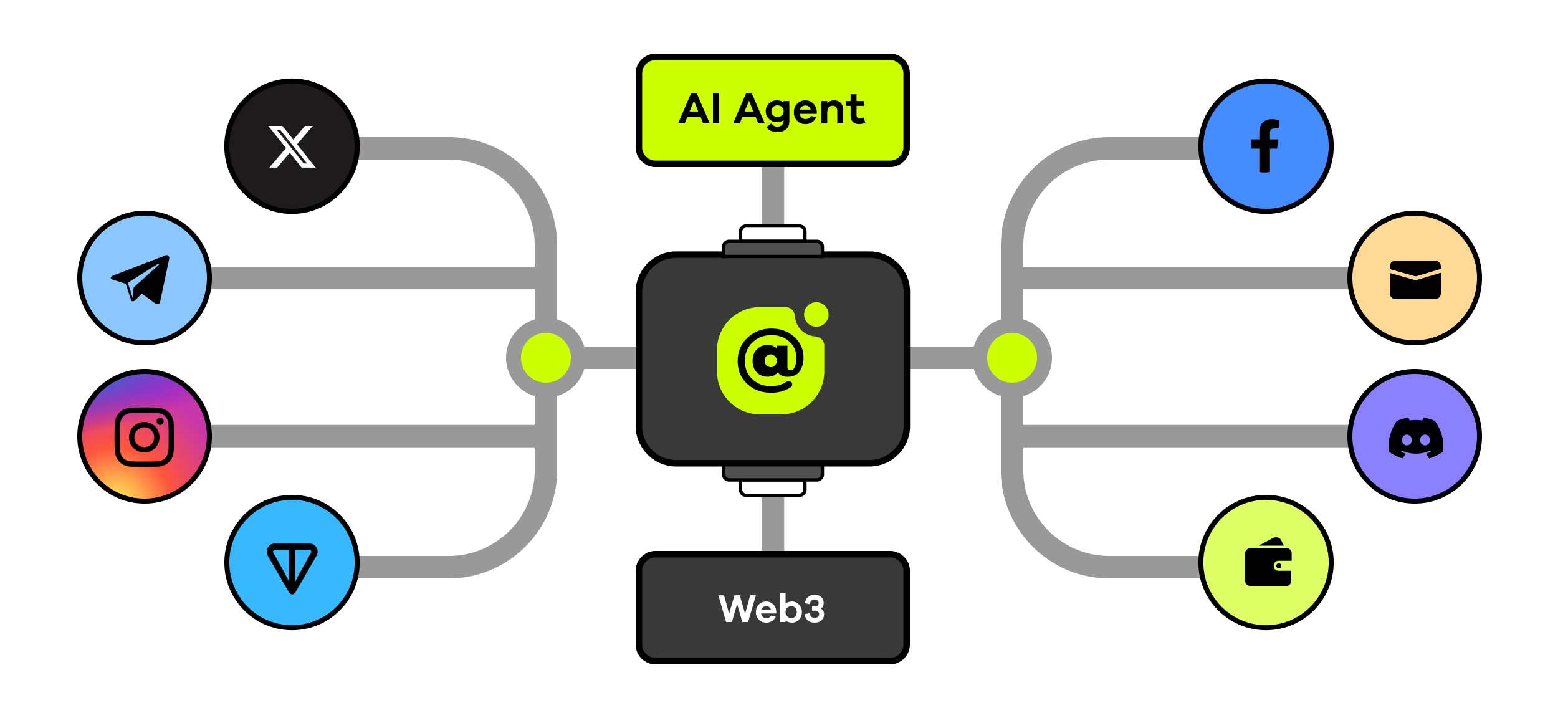
Data Productivity in Web3 — Agent#
In Web3, the true value of data lies not only in its availability, but in its intelligent transformation into actionable trading decisions. With the rapid expansion of decentralized finance, transactional data—such as wallet behavior, DEX/CEX trading activities, liquidity movements, asset transfers, and gas usage—has become a core resource for traders and protocols alike.
AI Agents built on large language models (LLMs) unlock this value by deeply analyzing both real-time on-chain and aggregated off-chain trading data. These Agents help users identify emerging trading opportunities, optimize entry and exit timing, detect arbitrage paths, and adjust portfolio strategies dynamically based on market shifts.
By automating data extraction and decision-making processes, Agents significantly reduce the complexity of Web3 interactions. Traders gain access to real-time, multi-dimensional market insights—from token movements to liquidity patterns—without needing to manually decode blockchain data or API feeds.
Agent-driven systems maximize the productivity of Web3 participants by:
1.Integrating fragmented trading signals across chains and platforms
2.Transforming transaction histories into predictive models
3.Personalizing trading strategies based on user behavior and intent
4.Streamlining execution across CEX, DEX, and wallet interfaces
As intelligent front-ends to complex trading ecosystems, these Agents elevate users from passive participants to empowered decision-makers, making Web3 trading more data-driven, efficient, and accessible.
Ultimately, trading-focused Agents are not just tools for individual optimization—they are catalysts accelerating the evolution of the entire decentralized financial landscape.
Based on the above logic, LinkLayerAI constructs a comprehensive protocol solution by combining Agent SaaS(AaaS) and Strategy Agent with smart contracts and DeFi.
Trading Data Issues in the Web3#
In the current Web3 trading landscape, while the entry barrier for retail investors and small-scale traders is relatively low, they face significant disadvantages compared to professional quantitative and trading teams. For retail investors, the primary challenge lies in the inefficiency of coin selection. Most rely on manual, time-consuming processes to screen cryptocurrencies, making it difficult to achieve real-time, data-driven decisions. This lack of efficiency and precision often results in missed opportunities and suboptimal trading outcomes.
For small-scale traders, the key pain point is the inability to automate their strategies. While many possess effective trading strategies, they lack the technical expertise or resources to develop the necessary code for automation. Additionally, the cost and complexity of hiring developers or building custom tools deter them from implementing their strategies at scale. As a result, their strategies remain underutilized, limiting their ability to compete with larger, more resourceful trading teams.
These challenges highlight a critical bottleneck in Web3 trading: the lack of accessible, data-driven tools for mid-to-small traders. This disparity not only hinders the growth of individual traders but also contributes to increasing liquidity centralization, as professional teams continue to dominate the market with their superior tools and resources. Addressing these pain points is essential to democratizing Web3 trading and fostering a more balanced, inclusive ecosystem.
LinkLayerAI’s Solution#
LinkLayerAI addresses these challenges by leveraging the synergy of Web3 and AI to redefine the trading landscape. By combining Agent technology with smart contracts, LinkLayerAI empowers trading data and roles—including users, traders, and trading communities—through AI-driven capabilities, creating a more efficient and accessible ecosystem.
Through the Strategy Agent and AaaS (Agent as a Service) systems, LinkLayerAI enables users and traders to harness real-time, data-driven insights and automate their strategies without requiring technical expertise. Retail investors can rely on AI to efficiently and accurately select cryptocurrencies, while small-scale traders can implement their strategies seamlessly through no-code tools, breaking down barriers to automation and scalability.
Moreover, LinkLayerAI fosters a decentralized ecosystem where all participants can share in the value they create. By integrating smart contracts, the platform ensures that users, traders, and communities are fairly rewarded for their contributions, enabling decentralized ownership of the ecosystem’s growth and success. This approach not only democratizes access to advanced trading tools but also promotes collaboration and innovation, empowering participants to thrive in the Web3 trading environment.
As shown in the figure below, we will promote the realization of all this through three groups of products, including two groups of AI products and one group of decentralized protocols.
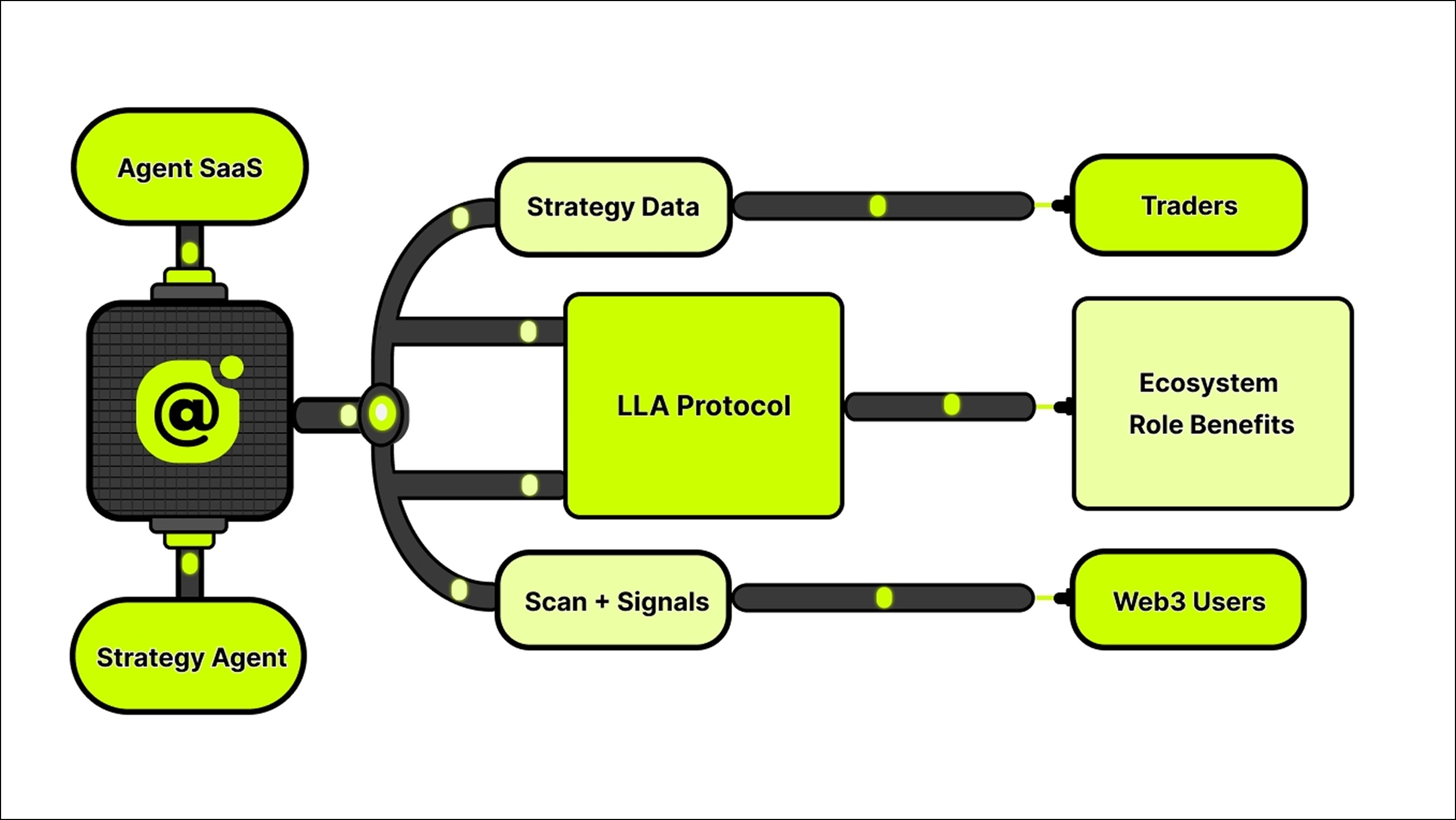
LinkLayerAI addresses the challenges of Web3 trading by seamlessly integrating AI and decentralized protocols to create a unified ecosystem that empowers users, traders, and communities. At the core of this solution are three interconnected components—AaaS (Agent SaaS), Strategy Agent, and LLA Protocol—which together redefine how trading data and ecosystem incentives are utilized and shared.
The foundation of this ecosystem lies in AaaS, a no-code SaaS platform that enables traders to deploy personalized trading Agents with ease. By leveraging natural language processing, traders can access real-time trading strategy data or customize their own strategies for natural language interaction. These Agents are not confined to individual use; they can be integrated into social platforms like Telegram, Discord, WhatsApp, and Line, allowing traders to share their strategies with their communities. This not only enhances the efficiency and accessibility of trading but also fosters collaboration and engagement within trading communities.
Complementing this is the Strategy Agent, a tool specifically designed for everyday users. It simplifies the complexities of trading by offering real-time coin-picking and signal data through natural language interaction. This allows non-professional users to make informed trading decisions without requiring technical expertise or extensive market knowledge, bridging the gap between advanced trading strategies and retail participants.
To ensure that all participants in the ecosystem are fairly rewarded and incentivized, LinkLayerAI introduces the LLA Protocol, a decentralized on-chain incentive system. Composed of multiple smart contracts, the protocol links the rights and rewards of different roles within the ecosystem. Whether it’s traders using AaaS to deploy Agents, users accessing Strategy Agent for real-time insights, or communities engaging with shared strategies, each action triggers specific scenarios that distribute corresponding rewards. This protocol not only incentivizes participation but also ensures that the value generated by AI services is shared across the ecosystem.
By combining these components, LinkLayerAI creates a self-sustaining ecosystem where AI services and Web3 protocols mutually reinforce each other. Traders and users benefit from enhanced trading efficiency and data-driven insights, while the decentralized incentive system ensures equitable value distribution. This dual synergy drives the sustainable growth of LinkLayerAI, linking all ecosystem participants through shared rights and rewards, and ultimately fostering a more inclusive and collaborative Web3 trading environment.
Link AI To Web3#
LinkLayerAI’s ultimate vision is to bridge the transformative power of AI with the decentralized ethos of Web3, creating a seamless connection between intelligent systems and decentralized ecosystems. By embedding AI capabilities into Web3 infrastructures, LinkLayerAI not only empowers users, traders, and communities with smarter tools and data-driven insights but also ensures that these advancements are distributed equitably through decentralized protocols.
At its core, LinkLayerAI aims to redefine the way individuals and communities interact with data, trading strategies, and incentives. Through tools like AaaS and Strategy Agent, AI becomes a catalyst for simplifying complex processes, automating strategies, and unlocking the value of real-time data. Meanwhile, the LLA Protocol ensures that every participant in the ecosystem—whether a retail user, a trader, or a community leader—shares in the growth and rewards of the ecosystem.
This vision goes beyond just improving trading efficiency; it’s about creating a sustainable, decentralized framework where AI and Web3 mutually reinforce each other. By linking AI to Web3, LinkLayerAI not only democratizes access to advanced technologies but also promotes a fairer, more inclusive digital economy. Ultimately, LinkLayerAI strives to build a future where AI and Web3 work hand-in-hand to empower individuals, foster collaboration, and drive the sustainable evolution of decentralized ecosystems.
To bring this vision to life, LinkLayerAI has developed a comprehensive ecosystem built on the foundation of the LLA Protocol, innovative AI-powered products, and a carefully designed economic model. These elements work together to ensure that every participant in the ecosystem—whether a user, trader, or community member—can benefit from the seamless integration of AI and Web3. In the following sections, we will delve deeper into the details of the LLA Protocol, our core products, and the economic framework that drives the sustainable growth of LinkLayerAI.
LLA Protocol#
The LLA Protocol is the native decentralized protocol of LinkLayerAI, deployed on Binance Smart Chain (BSC) and Erbie Chain. It is composed of multiple smart contracts designed to facilitate decentralized rights distribution and interactions across various roles and scenarios within the LinkLayerAI ecosystem. The protocol leverages a token-based system, including LLA, LLAx, XL, and L, to measure and reward the contributions and behaviors of different ecosystem participants.
The LLA Protocol is built to support multiple roles—Agent User, AaaS Trader, Web3 User, LLA Staker, and Early Investor—and operates across several key scenarios, such as product payments, staking, cross-chain token exchanges, and task-based rewards. By integrating these roles and scenarios, the protocol aims to create a fair and transparent ecosystem that incentivizes participation and collaboration.
The LLA Protocol defines several key roles, each with specific functions and interactions within the ecosystem:
Agent User:
Description: Users of the Strategy Agent product who pay for services in USDT or USDC.
Incentives: Receive LLAx rewards for using the product.
Interaction: Payments are directed to the treasury, and LLAx can be exchanged for LLA on Binance Smart Chain.
AaaS Trader:
Description: Traders who utilize the Agent SaaS (AaaS) product to automate and optimize their trading strategies.
Incentives: Receive LLAx rewards for using AaaS services.
Interaction: Payments in USDT or USDC are directed to the treasury, and LLAx can be converted into LLA.
LLA Staker:
Description: Participants who stake LLA tokens to support the ecosystem.
Incentives: Receive inflationary LLA rewards for staking.
Interaction: Staking and reward distribution are managed through Binance Smart Chain contracts.
Early Investor:
Description: Early supporters of the LinkLayerAI project who invested in LLA during its initial phases.
Incentives: Receive staged distributions of LLA tokens as part of their investment returns.
Interaction: Managed through Binance Smart Chain contracts.
The LLA Protocol operates across several key scenarios, each designed to incentivize participation and ensure fair distribution of rewards:
Product Payments and Rewards (Binance Smart Chain):
Agent User: Pays for Strategy Agent services in USDT or USDC and receives LLAx rewards.
AaaS Trader: Pays for AaaS services in USDT or USDC and receives LLAx rewards.
Treasury Management: Payments are directed to the treasury, ensuring sustainable ecosystem funding.
LLA Staker: Stakes LLA tokens to earn inflationary rewards.
Reward Distribution: Managed through Binance Smart Chain contracts.
Early Investment Returns (Binance Smart Chain):
Early Investor: Receives staged distributions of LLA tokens as part of their investment returns.
Cross-Chain Token Exchange:
LLAx to LLA: LLAx tokens can be converted to LLA at a predefined ratio on Binance Smart Chain.
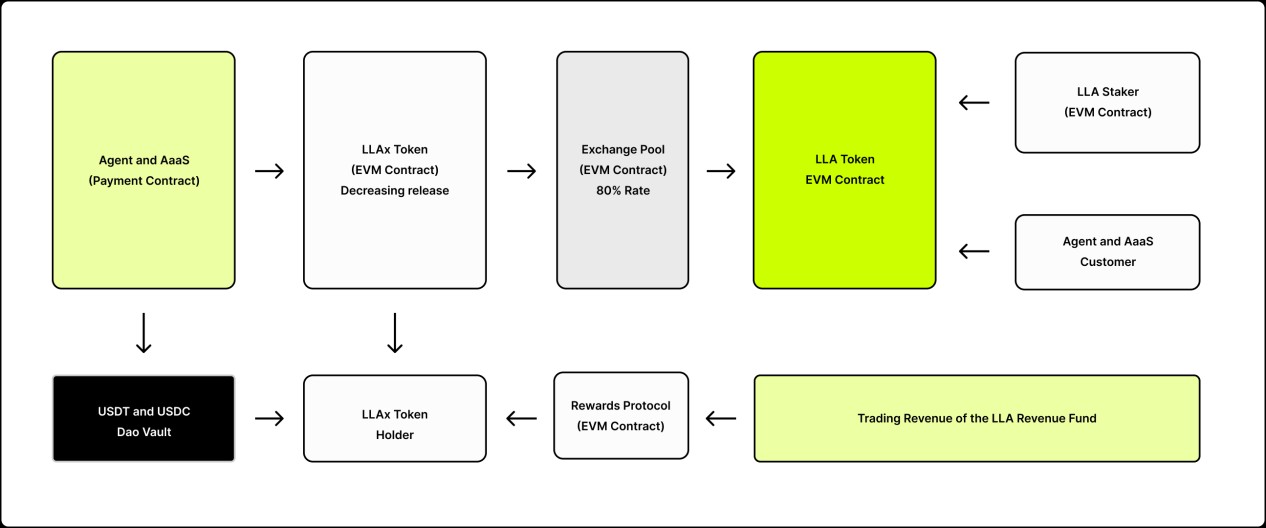
Conclusion
The LLA Protocol represents the backbone of the LinkLayerAI ecosystem, seamlessly integrating decentralized rights distribution, cross-chain interactions, and token-based incentives to create a fair and transparent environment for all participants. By leveraging the power of blockchain technology on Binance Smart Chain, the protocol ensures that every role—whether it’s an Agent User, AaaS Trader, LLA Staker, or Early Investor—can actively contribute to and benefit from the ecosystem.
The protocol’s design reflects a commitment to inclusivity and innovation. Through its token system (LLA, LLAx), it provides a robust mechanism to measure and reward contributions, while its smart contract architecture ensures secure and efficient interactions across various scenarios. The ability to link diverse roles and activities through cross-chain functionality further amplifies the protocol’s potential, fostering collaboration and synergy within the Web3 space.
As LinkLayerAI continues to evolve, the LLA Protocol will play a pivotal role in driving ecosystem growth and sustainability. By empowering participants with tools and incentives to engage meaningfully, the protocol not only enhances productivity but also strengthens the interconnectedness of the Web3 ecosystem. Whether you are a user, trader, staker, or early investor, the LLA Protocol provides a foundation for participation, innovation, and shared success.
LLA Products#
Agent SaaS :
For professional traders, our AaaS (Agent as a Service) platform offers a revolutionary no-code environment that enables them to build, test, deploy, and customize their own intelligent trading agents. While many traders possess deep market insight and excel in crafting innovative and effective trading strategies, they often lack the programming expertise to translate those strategies into executable code. Our AaaS platform bridges this gap by allowing users to define complex strategies directly using natural language, without writing a single line of code.
In addition to agent creation, we provide a full-featured backtesting environment that enables traders to evaluate the historical performance of their strategies, also through natural language prompts. Users can simulate trading behavior against historical market data to fine-tune their parameters and validate their hypotheses with precision and ease.
Furthermore, AaaS agents can be seamlessly integrated with our robust API library, allowing for flexible customization, continuous optimization, and real-time interaction with live markets—all based on natural language inputs. This opens the door to an entirely new class of trading experience that is intelligent, automated, and accessible to all strategy-oriented traders.
Strategy Agent:
The Strategy Agent is a cutting-edge intelligent assistant designed to empower users with real-time, actionable trading insights derived from comprehensive cryptocurrency exchange data. This tool is particularly valuable for users who seek to make informed and strategic decisions but are not well-versed in technical indicators, algorithmic analysis, or market structure.
By interpreting complex data sets and converting them into clear, concise, and user-friendly outputs, the Strategy Agent simplifies the decision-making process and acts as a bridge between raw trading data and practical execution. One of its standout capabilities is the ability to track and monitor the real-time price trends of individual tokens, offering users up-to-date analysis and alerts for trend shifts, volume surges, or potential entry and exit points.
Through natural language queries, users can access insights tailored to their interests—whether it’s short-term momentum, long-term trend shifts, or specific technical setups—all without needing to sift through charts or master complex trading tools. With the Strategy Agent, powerful trading intelligence becomes accessible to every user, regardless of technical background.
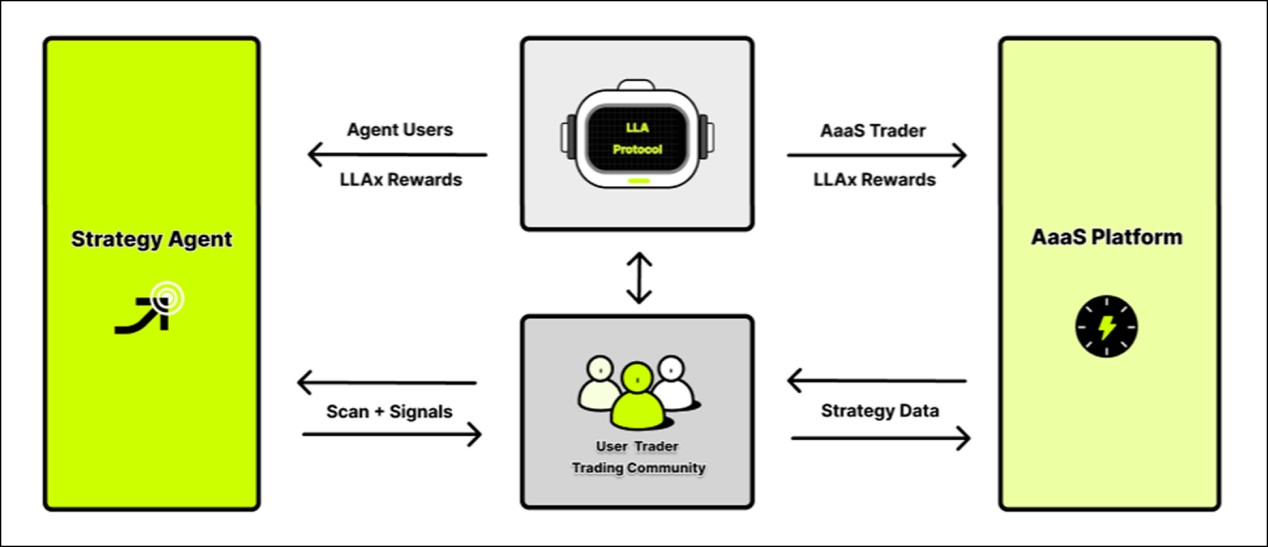
Economics#
Roles#
In the economic framework of the LinkLayerAI project, clearly defining ecosystem roles is crucial. Each role’s unique contributions are directly linked to their respective rights, which are reflected in the value of Tokens. This structure ensures a positive correlation between individual input and rewards, incentivizing active participation and fostering sustainable development and liquidity within the ecosystem.
◾Web User: A Web User is a participant in the LinkLayerAI ecosystem who engages with Agents and the AaaS (Agent as a Service) platform through valuable interactions. By performing tasks such as executing strategies, querying data, and using intelligent agents via natural language, users contribute meaningful activity to the network. These contributions are recognized and rewarded with rights points, which may qualify users for future airdrops of the governance token LLA, reflecting their role in the data assetization process.
◾Agent User: By subscribing to LinkLayerAI’s Strategy Agent services via contracts, users receive corresponding rights certificates (LLAx), which ultimately correspond to the governance token LLA.
◾AaaS Trader: By subscribing to LinkLayerAI’s AaaS services via contracts, customers obtain corresponding rights certificates (LLAx), which ultimately correspond to the governance token LLA.
◾Protocol Staker: By staking the governance token LLA, participants receive a certain proportion of LLA inflation rewards.
◾Early Investors: By investing in LinkLayerAI, early investors gain early liquidity of LLA.
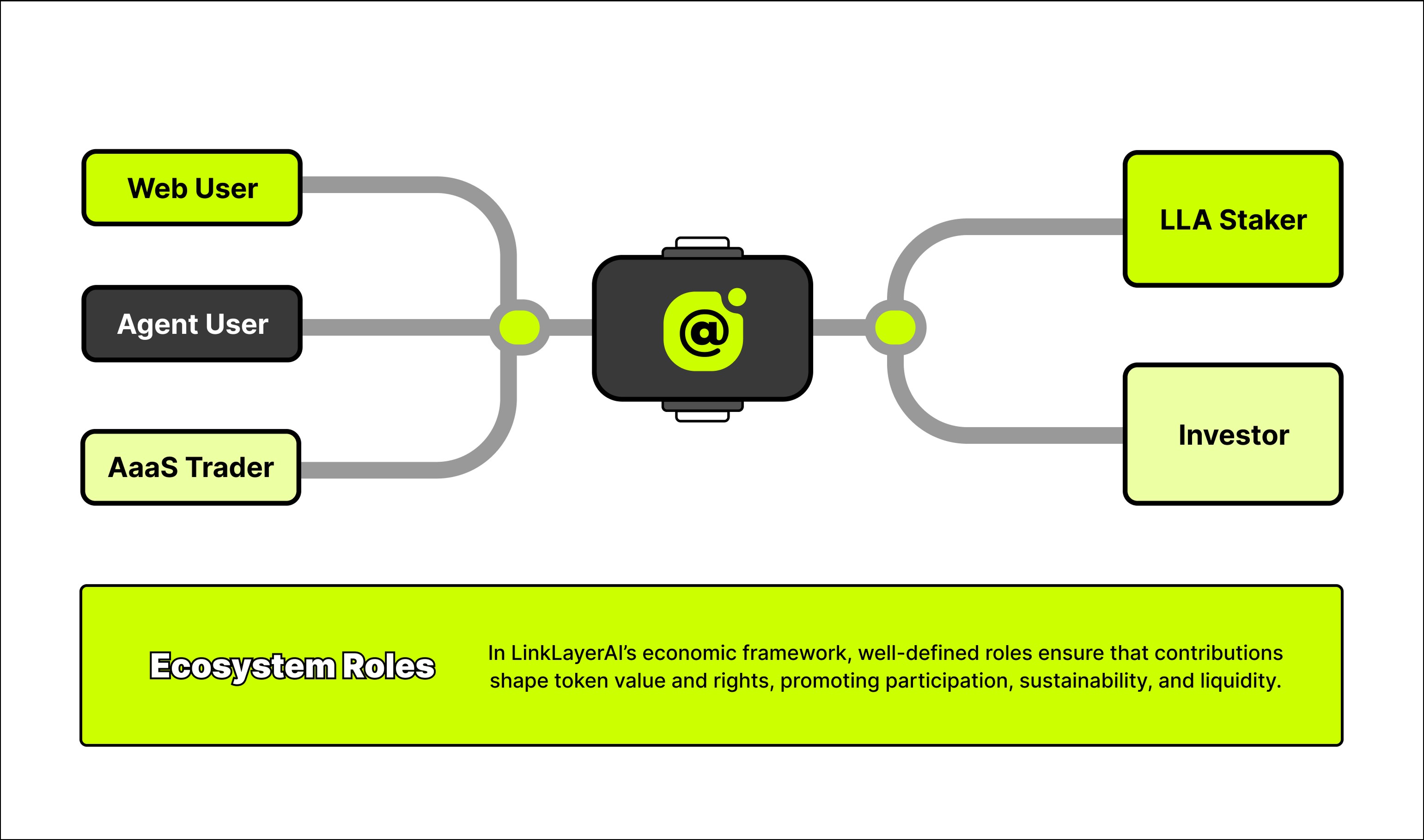
Introduction to LinkLayerAI’s Token#
To drive the development of LinkLayerAI’s diversified Agents and on-chain data tokenization, three different types of Tokens are used to stimulate the entire ecosystem:
✅ Governance Token LLA (to be issued on Binance Smart Chain), primarily used to measure the decentralized financial rights of different ecosystem roles.
LLA will be the governance token of the entire LinkLayerAI ecosystem. It will be used to build a distribution mechanism around the Agent + DeFi + data tokenization ecosystem. The total supply is confirmed to be 1 billion tokens, and further details will be announced before the TGE.
✅ Agent Rewards LLAx (to be issued on Binance Smart Chain),mainly used to measure the on-chain rights and interests of Agent Usecase users.
LLAx is the native incentive token of the LinkLayerAI Agent ecosystem, issued on BSC to measure and reward the on-chain rights of Agent Usecase users. Holding LLAx unlocks premium services, priority processing, and enhanced AI interactions. Users can earn rewards by contributing data, using AI services, and engaging in the ecosystem, driving a smarter Web3 experience.
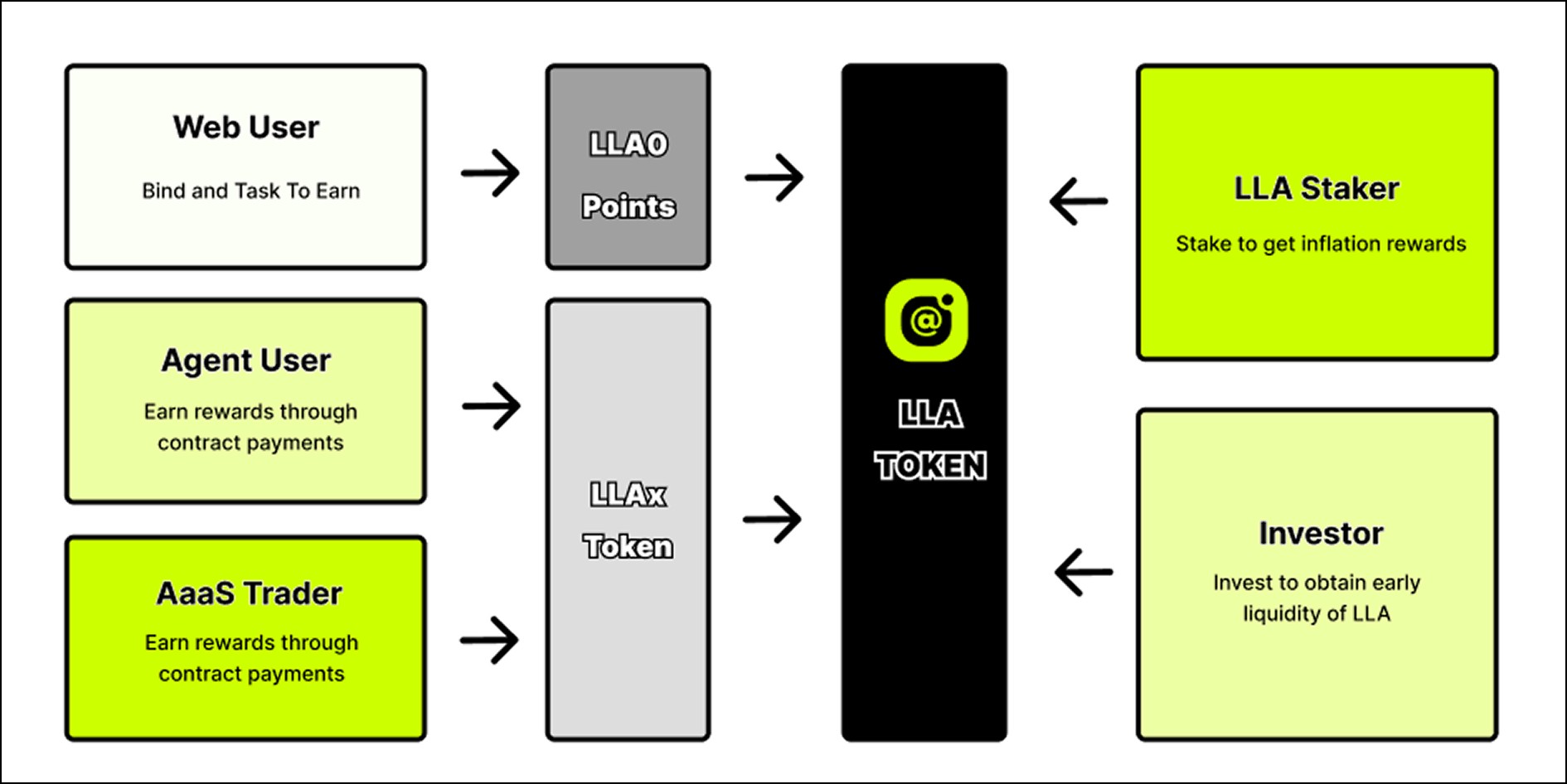
Roadmap#
The team will develop a roadmap for the project on an annual basis to promote long-term sustainable growth and adapt to market changes, aiming to make LinkLayerAI the world’s largest AI Strategy data platform. Here is the roadmap for 2024 and 2025

2024
Q1: Proposal of the Entire Project Architecture and Theoretical Feasibility Validation In the first quarter, we will outline the entire project architecture and validate its feasibility from a theoretical perspective.
Q2: Technical Development of Relevant Products and Targeted Stress Testing During the second quarter, we will focus on technical development of related products and conduct targeted stress tests.
Q3: Launch of LinkLayerAI’s Multi-Product Lines, Entering Data Collection Phase Q3 will see the launch of LinkLayerAI’s multi-product lines and entry into the data collection phase.
Q4: Develop the Strategy Agent Framework and AaaS System to enable real-time data processing, natural language interactions, and personalized trading strategies, forming the core of the LinkLayerAI ecosystem.
2025
Q1-Q2: Launch the beta version of Agent SaaS and Strategy Agent, with support for full Binance trading data.
Q3-Q4: Launch the official version of Agent SaaS and Trading Agent, with full trading data support from CEX and DEX.
Conclusion#
LinkLayerAI aims to become the largest network data assetization platform by leveraging Agents and AaaS (Agent-as-a-Service) to drive diversified DataFi Protocols, establishing a multi-dimensional data supply-demand relationship between users and projects. This model not only enhances the flexibility and composability of DataFi Protocols but also maximizes the benefits and interoperability of all participants. It aggregates and monetizes fragmented web data while balancing weak value points within the ecosystem. This foundation is crucial for expanding the user base, fostering a positive cycle, and ultimately driving large-scale migration from Web2 to Web3.
Web2 holds valuable user behavior data, whereas Web3 primarily relies on blockchain-based transactional data, creating a significant gap. LinkLayerAI bridges this data value gap by integrating intelligent Agents and AaaS with DeFi smart contracts, enabling seamless data assetization and value circulation across Web2 and Web3.
Version History#
📅June 2024 : Version 1.0.0, introduction of the project’s basic framework and logic.
📆February 2025 : Version 1.0.1, added introduction of Agent SaaS and Web3 Contract Agent.
📆March2025 : Version 1.0.2,added the logic of Agent and AaaS driving DataFi Protocols.
📆June 2025:Version 1.0.3,a comprehensive logical framework has been built around the foundation of the Incentive Protocol enabled by Strategy Agent and AaaS.